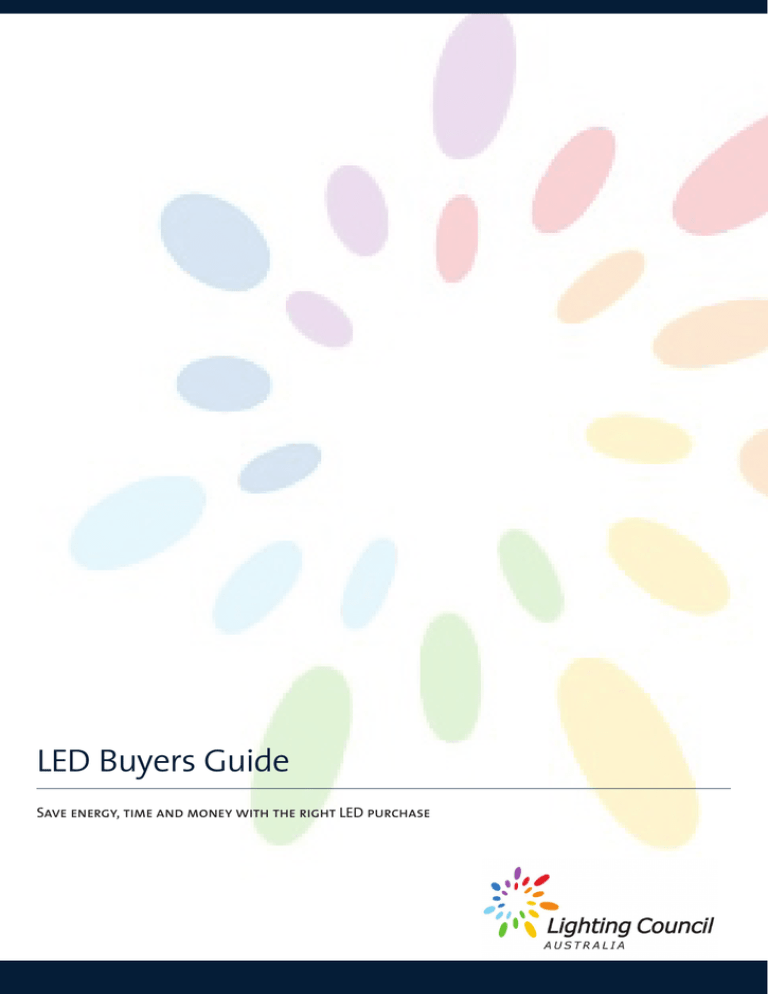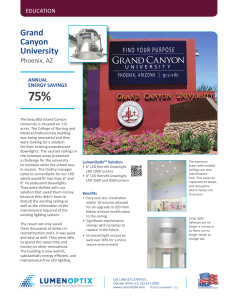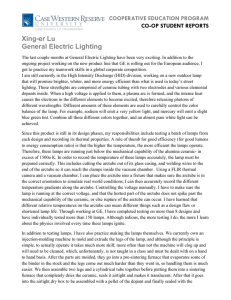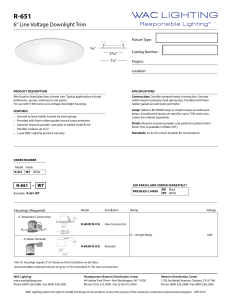LED Buyers Guide - Lighting Council Australia
advertisement

LED Buyers Guide Save energy, time and money with the right LED purchase Save energy, time and money with the right LED purchase This guide has been prepared to educate and assist consumers select safe, suitable, good quality LED lighting products. 1 LED lamps and fittings (LEDs) are quickly gaining popularity in household use and there are some excellent LED products available now in Australia. However, examination of LED products found in the Australian market indicates a wide variation in product safety, quality, effectiveness and compatibility. Low quality LEDs may be unsafe, not provide sufficient light, flicker when dimmed, change colour over time, fail prematurely, or not fit into an existing fitting. LEDs produce similar light output to traditional incandescent and halogen lamps and use much less energy. Incandescent and halogen lamps waste most of the energy they use as heat when they produce light. LEDs are comparable to the most efficient technologies available and even though more expensive initially will save money and time over their lifetime as they have a long lifetime, use very little energy and do not require regular replacement like halogen lamps. 2 Some LEDs are able to be dimmed or offer convenient features such as daylight harvesting , motion sensing and wireless control. Coloured lighting effects are available with some LEDs. If you decide to update your existing lighting, you have the option of choosing: New LED Lamps New LED Downlight Fitting 3 Compliance with regulations 4 The Regulatory Compliance Mark (RCM) is an important safety mark from Australia’s electrical safety and electromagnetic compatibility regulators and should be visible on the product. In addition, the brand must be registered on the Australian Government National Equipment Registration System. Unregistered brands and suppliers may be supplying equipment that does not meet Australian standards and regulations. 1. Sometimes called ‘light globes’ or ‘light bulbs’, but more correctly referred to as ‘lamps’. Daylight harvesting refers to LEDs that automatically adjust their light level depending on the natural light entering a room to maintain an even light level. 2. 3. A licensed electrician is required to install new fittings. The Regulatory Compliance Mark (RCM) demonstrates that the product manufacturer recognises and declares their product meets the Australian electrical safety and electro-magnetic compatibility requirements. Marking requirements are currently in transition and suppliers have until 1 March 2018 for products to be marked. 4. Brightness (think lumens, not Watts) When buying new LEDs, you should check the lumen output of each LED lamp or fitting to make sure you obtain the brightness you need. Lumens, which are a measure of total light output, should be listed on the product packaging. Higher lumens mean brighter light. The following comparison chart will help you find a suitable replacement. Traditional incandescent lamp (Watts) Brightness in lumens 100W 1350 lumens 75W 930 lumens 60W 720 lumens 40W 420 lumens Downlight lamps – MR16 type (Watts) Brightness in lumens (approximate) 50W## 700 lumens 35W 450 lumens ## 50W downlight lamps are no longer available for purchase but may still be in use. Downlight lamps – GU10 type (Watts) Brightness in lumens (approximate) 50W 350 lumens Beam angle The angle of the beam of light emitted from the lamp or fitting can be important for your application. Check to see if you require a wide or narrow beam angle. A wider beam angle gives a more even spread of light and a beam angle of 60o or more is recommended for general lighting from downlights. A narrow beam angle can result in bright spots and shadowing which is not usually desired. However, a narrow beam can be suitable for highlighting a picture, display piece or other feature. Lamp efficiency Even though LEDs are a very efficient lighting technology, the efficiency of various LEDs can vary considerably. Lumens per Watt (lm/W) is the measure of LED efficiency and the higher the number, the more efficient the product. Colour temperature and colour rendering Personal preference and use dictates choice of LED colour temperature. •Warm white light is shown as 2700K to 3000K, is close to traditional incandescent and halogen lamp colour and is typically used in living rooms, bedrooms and hallways to create relaxed, warm ambience. •Cool white light is shown as 4000K and is typically used in the kitchen, study, bathroom, cupboard, office (for alertness) and retail displays. •Cool daylight white light is shown as 6500K and is typically used in commercial applications, hospitals, retail displays and art studios. The Colour Rendering Index (CRI) of a lamp or fitting is a measure of a light source’s ability to show object colours realistically or naturally. A CRI of 80 or above should be sought. Compatibility Check the fitting type, size, beam angle and dimming compatibility of your new LEDs. •Take an old lamp to compare with the new LED. Check the type and size of the base, beam angle, voltage, overall size and shape of the lamp. Some LED replacement lamps are larger than traditional lamps and may not be compatible with some fittings. •When buying complete downlight replacement kits you will need to know the hole cut out size. Shop around until you find the right sized LED replacement fitting. •LED lamps and downlights are now available to replace halogen lamps and 35W halogen downlights. • Look for LEDs of around 450 - 500 lumens to achieve similar results to your 35W halogen downlights. •Make sure that LED downlight replacement fittings come with a matching power supply (also known as a driver). Some will claim to operate on existing halogen transformers but such claims should be treated with caution especially where compatibility with existing dimmers is required. •Dimmable LED lamps, fittings and downlights are now available. “Dimmable” should be marked on the product packaging. •Compatibility between existing wall switch dimmers and dimmable LED lamps, fittings or downlights cannot be guaranteed. Universal dimmers are available but even these are not guaranteed to operate all LEDs. Reputable brands provide compatibility charts that list the popular dimmers compatible with their LEDs. Most installed dimmers were originally designed to dim low voltage halogen lamps and it is unlikely that these old dimmers will dim LED lamps in a similar way. Check with the LED supplier for a list of dimmers compatible with their LEDs. Lighting tips Follow these tips to keep your lighting costs down. •Switching to LEDs is one of the fastest and easiest ways to cut your energy bills. Switching to LEDs will reduce growth in Australia’s energy demand and avoid carbon emissions. • Use task lighting to supplement general lighting when needed. • Lightly coloured walls appear brighter and better lit than dark surfaces. • Replace incandescent, halogen and fluorescent lamps with LEDs. •Turn off lights when rooms are not being used. Some lamps have enabled wireless control from a smart device and so may be switched on and off from the device. •Control outdoor lights with timers, motion sensors or photocells so that lights are not on all night or during the day. If outdoor lights are used for long periods each night, the use of LEDs in these fixtures can save significant energy. LED flood lights are available (check the beam angle you require). Wireless control of lamps is now also available. 5 •By replacing your five most used incandescent or halogen lamps with LEDS, you can save between $71 and $91 each year . •LEDs are available in sizes compatible with most fittings and they provide the greatest savings when used in fittings that are on for the longest periods each day. •Dimmers save electricity when lower light levels are set. Not all dimmers and dimmable LEDs are compatible. Reputable LED suppliers provide compatibility charts listing dimmer brands and types. Quality label for LEDs Brand Name: ABC Company Supplier/Product ID: 001/001 LED Performance Solid State Lighting Luminaire Luminous Flux Luminous Efficacy 865 lm 58 lm/W INPUT POWER 15 W TEST VOLTAGE 240V AC Colour Correlated Colour Temperature (CCT) Colour Rendering Index (CRI, Ra) LIGHT COLOUR WARM WHITE 2600K COOL WHITE 3200K 4000 K 85 [4000K COOL WHITE] Correlated Colour Temperature (CCT) DAYLIGHT 4500K 6500K Visit www.lightingcouncil.com.au for the Label Reference Guide The specifications above are contained in certified or accredited reports provided to Lighting Council Australia Ltd by the manufacturer/supplier of this product. Lighting Council Australia makes no representation as to the product’s specification or suitability. Dimmable Lighting Council Australia’s Solid State Lighting Quality Scheme is a third party, voluntary, industry program providing confidence that an LED product carrying the scheme’s label (sample shown) matches the performance claims made by the supplier (energy efficiency, lumens, light output and colour temperature) and helps consumers understand and compare lamps they are considering purchasing. Registered products appear on a searchable database on Lighting Council’s website. Non-dimmable 5 Based on replacing 60W incandescent or 42W halogen lamps with 8W LEDs with usage averaging 4hrs per day, 25c per kWh, shown in Australian dollars. Cost comparison (standard lamp type) 6 Average annual operating cost per household lamp* Traditional (old style) incandescent (60W)** Halogen incandescent (42W) Good quality CFL (10W) Good quality LED (8W) $21.90 $17.88 $5.35 $3.62 *For 60W incandescent lamp and replacements, based on 4 hrs/day of usage, 25c per kWh and including the annualised cost of the lamp (initial cost divided by the lamp life in years) - shown in Australian dollars. ** Incandescent lamps (40W – 100W) are no longer available for purchase but may still be in use. 7 Cost comparison (commonly installed downlight lamps###) Average annual operating cost per household downlight# 50W halogen lamp## 35W halogen lamp Good quality 7W LED downlight lamp $18.25## $16.79 $3.43 #For 35W and 50W halogen downlights and LED replacement, based on 4 hrs/day of usage, 25c per kWh and including the annualised cost of the lamps (initial cost divided by the lamp life in years) - shown in Australian dollars. ## ### Halogen downlights use a great deal of energy including producing a great deal of heat. Low voltage does not mean low energy use. 50W downlight lamps are no longer available for purchase but may still be in use. 6 All information including average market pricing is relevant at the time of publishing. See appendix A for assumptions and calculations. 7 All information including average market pricing is relevant at the time of publishing. See appendix A for assumptions and calculations. Lifetime and warranty There are many factors that determine the lifetime of a LED lamp or fitting including light loss and possible failure of components. Reputable manufacturer claims are based on rigorous testing and are reliable. A warranty is a voluntary promise of a manufacturer’s confidence that the product will achieve an expected life. Check the warranty conditions and note that any warranty offered with a product is in addition to other rights the consumer may have under the Australian Consumer Law. The Australian Competition and Consumer Commission (www.accc.gov.au) has information on consumer rights, guarantees and warranties. Use electrical contractors to install fittings Apart from lamp replacement, a licensed electrical contractor is required to repair, service or install any light fitting, driver (power supply) or dimmer that is attached to the 240V mains power. Electrical contractors are responsible for installation safety and must refuse to install non-compliant products. Installation by unqualified persons can result in electric shock or fire. Sale and installation of non-compliant products or installation by unqualified persons can result in electric shock, fire, penalties and fines. About Lighting Council Australia Lighting Council Australia is the peak body for Australia’s lighting industry. Its members include manufacturers and suppliers of luminaires, lighting control devices, lamps, solid state (LED) lighting and associated technologies. Lighting Council’s goal is to encourage the use of environmentally appropriate, energy efficient, quality lighting systems. See http://www.lightingcouncil.com.au/ for more information. Appendix A – A ssumptions and calculations for the cost comparison tables Average operating cost per household light fitting, per year. Standard lamp type Traditional (old style) incandescent (60W) Halogen incandescent (42W) Good quality CFL (10W) Lamp price (phased out 2009) $3.50 Annual lamp operating hours 1460 Estimated lamp life 60W incandescent lamps 1.37 (2000hrs) 4.1 (6000hrs) are no longer available $7.00 Good quality LED (8W) $12 17.12 in years (25000hrs) Annual lamp cost $2.55 $1.70 $0.70 Annual kWh of electricity 87.6kWh 61.32kWh 14.6kWh 11.68kWh Annual cost of electricity (25c per kWh) $21.90 $15.33 $3.65 $2.92 Total annual cost (electricity + lamp) $21.90** $17.88 $5.35 $3.62 ** Incandescent lamps (40W - 100W) are no longer available for purchase but may still be in use. Commonly installed downlight lamps 50W downlight lamp Lamp cost (Phased out 2009) Annual lamp operating hours 1460 hours Estimated lamp life in years 50W downlight lamps are no longer available 35W downlight lamp 7W LED downlight lamp $5.50 $15 1.37 (2000hrs) 17.1 (25000hrs) Annual lamp cost $4.01 $0.88 Annual kWh of electricity 73kWh 51.1kWh 10.2kWh Annual cost of electricity (25c per kWh) $18.25 $12.78 $2.55 Total cost (electricity + lamp) $18.25## $16.79 $3.43 ## 50W downlight lamps are no longer available for purchase but may still be in use.



